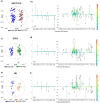NMR-based metabolomics of plasma from dairy calves infected with two primary causal agents of bovine respiratory disease (BRD)
- PMID: 36792613
- PMCID: PMC9930073
- DOI: 10.1038/s41598-023-29234-3
NMR-based metabolomics of plasma from dairy calves infected with two primary causal agents of bovine respiratory disease (BRD)
Abstract
Each year, bovine respiratory disease (BRD) results in significant economic loss in the cattle sector, and novel metabolic profiling for early diagnosis represents a promising tool for developing effective measures for disease management. Here, 1H-nuclear magnetic resonance (1H-NMR) spectra were used to characterize metabolites from blood plasma collected from male dairy calves (n = 10) intentionally infected with two of the main BRD causal agents, bovine respiratory syncytial virus (BRSV) and Mannheimia haemolytica (MH), to generate a well-defined metabolomic profile under controlled conditions. In response to infection, 46 metabolites (BRSV = 32, MH = 33) changed in concentration compared to the uninfected state. Fuel substrates and products exhibited a particularly strong effect, reflecting imbalances that occur during the immune response. Furthermore, 1H-NMR spectra from samples from the uninfected and infected stages were discriminated with an accuracy, sensitivity, and specificity ≥ 95% using chemometrics to model the changes associated with disease, suggesting that metabolic profiles can be used for further development, understanding, and validation of novel diagnostic tools.
© 2023. The Author(s).
Conflict of interest statement
The authors declare no competing interests.
Figures






Similar articles
-
Association of bovine respiratory disease or vaccination with serologic response in dairy heifer calves up to three months of age.Am J Vet Res. 2015 Mar;76(3):239-45. doi: 10.2460/ajvr.76.3.239. Am J Vet Res. 2015. PMID: 25710760
-
Cluster analysis of bovine respiratory disease (BRD)-associated pathogens shows the existence of two epidemiological patterns in BRD outbreaks.Vet Microbiol. 2023 May;280:109701. doi: 10.1016/j.vetmic.2023.109701. Epub 2023 Feb 17. Vet Microbiol. 2023. PMID: 36848816
-
Performance of multiple diagnostic methods in assessing the progression of bovine respiratory disease in calves challenged with infectious bovine rhinotracheitis virus and Mannheimia haemolytica1.J Anim Sci. 2019 May 30;97(6):2357-2367. doi: 10.1093/jas/skz107. J Anim Sci. 2019. PMID: 30923802 Free PMC article.
-
[Immunobiology of bovine respiratory syncytial virus infections].Tijdschr Diergeneeskd. 1998 Nov 15;123(22):658-62. Tijdschr Diergeneeskd. 1998. PMID: 9836385 Review. Dutch.
-
γδ T cells and the immune response to respiratory syncytial virus infection.Vet Immunol Immunopathol. 2016 Nov 15;181:24-29. doi: 10.1016/j.vetimm.2016.02.012. Epub 2016 Feb 21. Vet Immunol Immunopathol. 2016. PMID: 26923879 Review.
Cited by
-
Bovine Respiratory Syncytial Virus (BRSV) Infection Detected in Exhaled Breath Condensate of Dairy Calves by Near-Infrared Aquaphotomics.Molecules. 2022 Jan 16;27(2):549. doi: 10.3390/molecules27020549. Molecules. 2022. PMID: 35056864 Free PMC article.
-
Identification of diagnostic biomarkers of and immune cell infiltration analysis in bovine respiratory disease.Front Vet Sci. 2025 Mar 5;12:1556676. doi: 10.3389/fvets.2025.1556676. eCollection 2025. Front Vet Sci. 2025. PMID: 40110435 Free PMC article.
-
Blood gases, acid-base, and metabolic alterations in calves with bronchopneumonia diagnosed via clinical signs and thoracic ultrasonography: A cross-sectional study.J Vet Intern Med. 2024 May-Jun;38(3):1932-1940. doi: 10.1111/jvim.17039. Epub 2024 Mar 19. J Vet Intern Med. 2024. PMID: 38504475 Free PMC article.
-
Strategies for Bovine Respiratory Disease (BRD) Diagnosis and Prognosis: A Comprehensive Overview.Animals (Basel). 2024 Feb 16;14(4):627. doi: 10.3390/ani14040627. Animals (Basel). 2024. PMID: 38396598 Free PMC article. Review.
-
Effects of bovine respiratory disease on the plasma metabolome of beef steers during the receiving period.Front Vet Sci. 2023 Aug 4;10:1239651. doi: 10.3389/fvets.2023.1239651. eCollection 2023. Front Vet Sci. 2023. PMID: 37601765 Free PMC article.
References
-
- Kurćubić V, Đoković R, Ilić Z, Petrović M. Etiopathogenesis and economic significance of bovine respiratory disease complex (BRDC) Acta Agric. Serbica. 2018;23:85–100. doi: 10.5937/AASer1845085K. - DOI
Publication types
MeSH terms
Grants and funding
LinkOut - more resources
Full Text Sources
Medical

